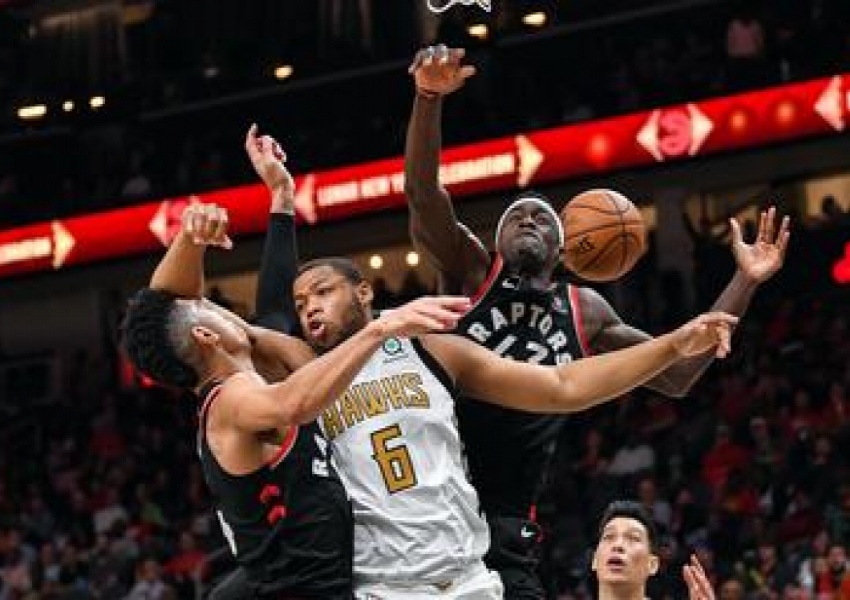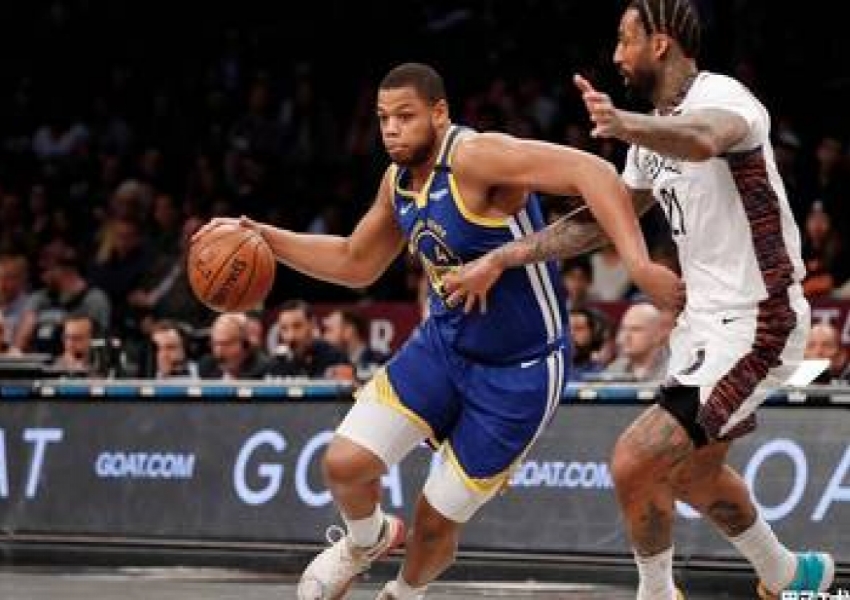From Golden Promise to Global Wanderer: The Rise and Fall of Omari Spellman, the Warriors’ Small-Ball Prototype
He was once dubbed a prototype for the modern NBA big man. A perfect blend of perimeter touch and interior toughness. A player who seemed tailored for the pace-and-space revolution ushered in by the Golden State Warriors. But just two years after leaving the Bay, Omari Spellman vanished from the NBA, replaced by stories of unmet potential and lingering questions. What happened to the once-promising forward who had all the tools but never quite put them together?

Omari Spellman’s story, like many in the league, began in adversity. Born into hardship, his father was incarcerated while Spellman was still young, leaving his mother Rochelle Wilson to raise him and his two sisters alone. They squeezed into a run-down apartment, scraping by while Spellman sought refuge on the basketball court—a place where your background didn’t matter, only your bounce, your skill, and your hunger.

Despite the chaos at home, Spellman managed to maintain a GPA of 3.2, showing promise both on and off the hardwood. But it was clear early on: basketball was his ticket out. His early career saw rapid ascension. After dominating at Pennsylvania’s The Master's School, he transferred to Massanutten Military Academy in Virginia. There, he met Coach Pat Kraft, a figure who would change the course of Spellman’s development.

Kraft saw what others didn’t—Spellman wasn’t a pure 5. He wasn’t just a post bruiser. He had range, court vision, and surprising agility for a player of his size. Kraft put him on a strict weight management program, emphasized skill development, and reimagined Spellman as a stretch four with defensive versatility. The results were staggering. In his senior year, Spellman averaged 28.4 points, 13.2 rebounds, and 4.3 blocks per game, leading his team to a 32-2 record and a state championship. In the title game alone, he posted 37 points and 19 rebounds. He left high school as a five-star recruit, ranked the No. 3 center in the country.
Spellman committed to Villanova University, a program known for its NBA-ready development and team-first style. It was a match made in basketball heaven. Under head coach Jay Wright, Spellman thrived in a “five-out” offense that maximized his passing, spacing, and outside shooting. In the 2018 NCAA Tournament, Spellman was a key cog. He scored 18 points and grabbed 8 boards against West Virginia in the Sweet 16, and followed it up with 15 and 9 in the Elite Eight. In the championship game, his stat line read modestly—8 points—but he corralled 11 rebounds, blocked three shots, and locked up Michigan’s star big man Moritz Wagner.
Over the entire March Madness run, Spellman averaged 11.8 points, 7.7 rebounds, 2.2 assists, 1.3 steals, and hit 45.2% from beyond the arc. Only Donte DiVincenzo posted a higher player efficiency rating for the Wildcats.
Spellman entered the 2018 NBA Draft with considerable buzz. At 6'8" with a 7'2" wingspan and a 245-pound frame, he fit the mold of a modern-day stretch four. His blend of size, shooting, and feel made him an intriguing option at the next level. The Atlanta Hawks selected him with the 30th overall pick.
In Atlanta, Spellman’s rookie year was rocky. He showed flashes of offensive talent but struggled with consistency and conditioning. After one season, he was traded to the Warriors—a franchise that had revolutionized the modern game and seemed like an ideal fit.
And for a brief moment, it was. In Golden State’s injury-riddled 2019-20 campaign, Spellman found a rhythm. He averaged 7.6 points and 4.5 rebounds per game while shooting 39.1% from three-point range. His mobility and spacing made him a fan favorite in the Bay Area. He seemed poised to carve out a long-term role as a rotational big in Steve Kerr’s system.
But the Warriors were preparing for the return of Steph Curry and Klay Thompson, and needed roster flexibility to reload. Despite his promise, Spellman became a trade chip—one of the few young assets with value. He was dealt to the Minnesota Timberwolves in a package for D’Angelo Russell. And that’s when the unraveling began.
Spellman didn’t take the trade well. Visibly emotional and frustrated, he reportedly told people close to him that he had no intention of suiting up for Minnesota. The Timberwolves, whether because of fit or friction, essentially shelved him. During that hiatus, Spellman’s self-discipline deteriorated. He ballooned in weight—reportedly tipping the scales at over 130 kilograms (nearly 290 pounds), 20 kilograms heavier than his listed weight when drafted.
Though he would later be traded to the Knicks, his opportunity never materialized. Reports from within the organization painted a bleak picture: poor conditioning, inconsistent effort, and a lack of professionalism. Less than two months into his Knicks stint, he was waived.
Spellman’s NBA career was over before his 24th birthday.
Since then, he’s bounced around the international circuit—stints in South Korea, Puerto Rico, Turkey, and most recently Russia. He’s shown flashes of his old self overseas but has never regained the form or mindset required to sustain an NBA role.
Jay Wright, the coach who helped shape Spellman’s game at Villanova, once said, “Omari was supposed to be a 10-year NBA starter. But when it mattered most, he always looked for shortcuts.” It’s a brutal but honest assessment. In the NBA, talent is only the entry fee. Professionalism, accountability, and self-awareness are what sustain a career.
And that’s where Spellman faltered. His fall wasn’t purely about skill—it was about attitude. In a league obsessed with spacing and shooting, Spellman should have thrived. But his clashes with management, inability to maintain physical conditioning, and lack of consistency turned front offices away.
The tragedy of Omari Spellman is that he did have what it took. He wasn’t some undrafted longshot or fringe talent. He was a national champion, a first-round pick, a modern big who could shoot and pass. But all of that potential became weight—both literal and figurative—that he couldn’t carry.
In a different timeline, Spellman could have been Draymond Lite: a smaller, bulkier big with a jump shot and enough savvy to make plays out of the short roll. Instead, he’s a cautionary tale for every prospect who thinks talent alone will carry the day.
Sometimes the difference between a decade-long career and a quick flameout isn’t skill. It’s everything else.
Copyright Statement:
Author: focusnba
Source: FocusNBA
The copyright of this article belongs to the author. Reproduction is not allowed without permission.
Recommended Blog
- 16 Points, 5 Turnovers: Where Exactly Did Anthony Edwards Fall Short Against SGA?
- Amen Thompson Season Review: From Defensive Specialist to Houston’s Two-Way Beacon of Hope
- The King of Boards: Just How Good Has Josh Hart Been This Postseason?
- Rare Rotation Brings Redemption: How Thibodeau's Nine-Man Strategy Powered the Knicks to a Critical Game 3 Win
- One More Year? At Nearly 39, What Does Al Horford Really Have Left in the Tank?
- Six-for-One: Did the 2022 Celtics-Pacers Trade Turn Out to Be a True Win-Win?
- Plus-Minus Disaster: What Went Wrong for Karl-Anthony Towns in Game 2?
- Non-Contact Nightmare: Tatum’s Achilles Scare Could Mark the Beginning of the End for the Celtics’ Core
- Win-Win Trade! Just How Valuable Has Alex Caruso Become in the Playoffs?
- What’s Going On With Nikola Jokic? Three Rare Subpar Games Raise Big Questions